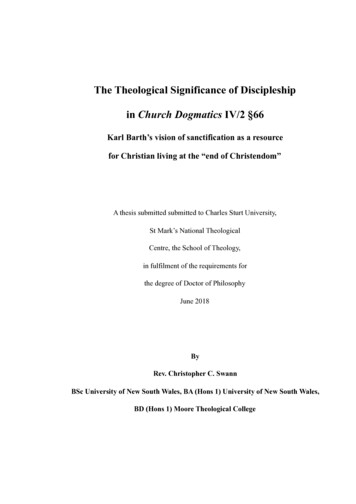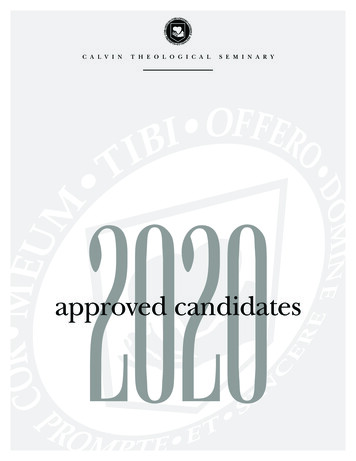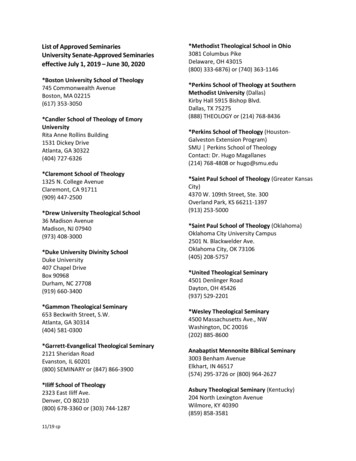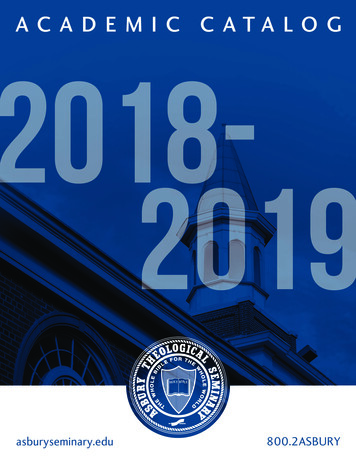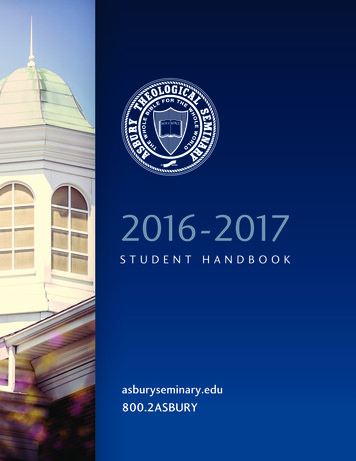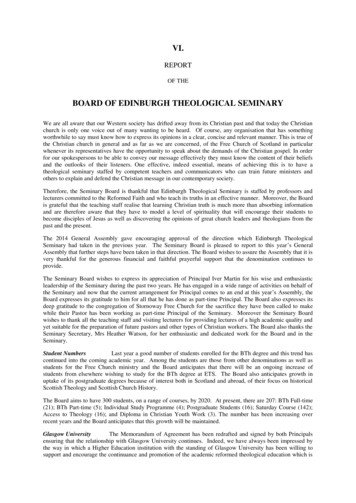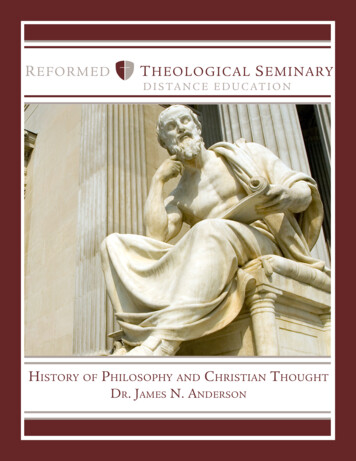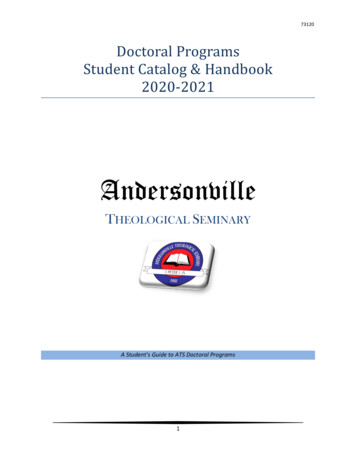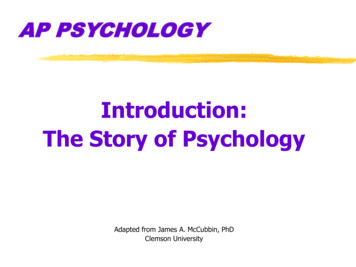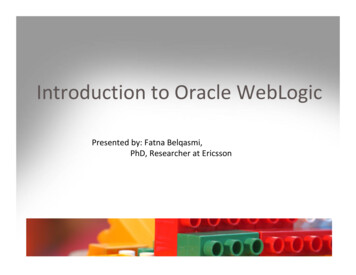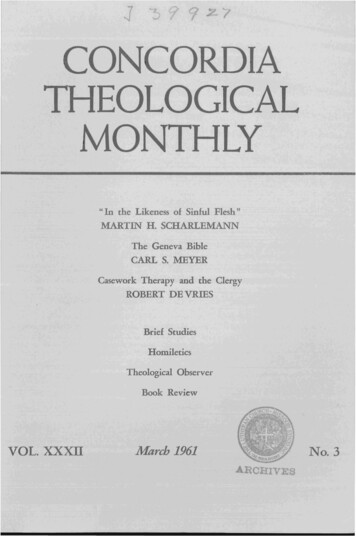
Transcription
J7CONCORDIATHEOLOGICALMONTHLY"In the Likeness of Sinful Flesh"MARTIN H. SCHARLEMANNThe Geneva BibleCARL S. MEYERCasework Therapy and the ClergyROBERT DE VRIESBrief StudiesHomileticsTheological ObserverBook Review!VOL. XXXIIMarch 1961No.3RCHIVE
The Geneva BibleByOApril 10, 1560, the last page of anEnglish Bible was taken off the pressin Geneva. To say that it "rolled off thepresses" would be an anachronism. Thetask of printing this Bible had been begunin January 1558. Twenty-seven monthstherefore were required for its printing"God knoweth with what fear and trembling we have been for the space of twoyears and more, day and night, occupiedherein," its translator-pressmen testify.1This was the famed Geneva Bible, now400 years old, which only slowly gave wayto the King James Version (1611) duringthe 17th century.2S. MEYERthe "Old Religion," which Mary espoused.They could not foresee the extent of thepersecutions under Mary; they believedthey were imminent and, with those whosettled in Frankfort and elsewhere, theyfled betimes. s After the death of Mary(Nov. 18, 1558) the refugees quickly returned to England.NIn the meanwhile, however, as noted, theprinting of the complete Bible was wellunder way. The activity could not betransferred to London, since no printer hadas yet been licensed to print Bibles andNew Testaments. 4 Eager as they might beto return to England, the translator-printershad to remain in Geneva to complete theirtask.Why was it published in Geneva?Geneva was the home of English refugeeswho had left England at the onset of MaryTudor's reign (1553). They were fearfulof the religious changes that would bebrought about-and well they might be.Of Puritanical bent, they had little love for1 Quoted by Christopher Anderson, The Annals of the English Bible (London: WilliamPickering, 1845), II, 319.2 Charles C. Butterworth, The Literary Lineage of the King James Bible, 1340-1611(Philadelphia: University of PennsylvaniaPress, 1941), p.163, calls it "the householdBible of the English people" for 50 years.Between 1560 and 1644 there were atleast 140 editions of the Geneva Bible or theGeneva New Testament. Fifty-seven years agothe British and Foreign Bible Society had collected 120 of these editions. T. H. Darlow andH. F. Moule, Historical Catalogue of the PrintedEditions of the Holy Scripture in the Library ofthe British and Foreign Bible Society (London:The Bible House, 1903), I (English), 61, 62,no. 77. Copy 364 of this work, printed in 500copies, now in the Concordia Seminary library,was used in preparing this article.CARLWilliam Whittingham, Anthony Gilby,and Thomas Sampson were the chief, perhaps the only, men responsible for the newtranslation. Their names are not given inthe preface, but there is general agreementamong investigators in ascribing the new3 C. H. Garrett, The Marian Exiles (Cambridge, 1938); H. J. Cowell, "The SixteendtCentury English Speaking Refugee Churches atGeneva and Frankfurt," Huguenot Society ProceedingJ, XVI (1939), 209-230; W. M. Southgate, "The Marian Exiles and the Influence ofJohn Calvin," History, XXVII (1942), 148to 152.4 On Jan. 8, 1561, Elizabeth granted a li·cense to John Bodley to print the Geneva Bible.See "Privilege and Licence to John Bodley forPrinting the Geneva Bible for Seven Years"printed from the original Patent Roll, 3 Elizabeth, Part 13 (34), 1. A. F. Pollard, Recordsof the English Bible: The Documents relatingto the Translation and Publication of the Biblein English, 1525-1611 (London: Oxford Uni·versity Press, 1911), pp. 284 f, no. XLVIII.139
140THE GENEVA BIBLEversion to these three men. 5 They hadcollaborators, even as they used previousEnglish versions of the Scriptures. Amongthese advisers were Goodman and Cox,Coverdale and Knox, Calvin and Beza.dale, Coverdale, and perhaps others contributed, each in his way, to this NewTestament of 1557, which was revised forthe Geneva Bible of 1560. NeverthelessButterworth's tribute is in order:Oxford-educated William WhittinghamNo one can handle this small, compact,careful, and courageous edition withouta feeling of respect for the work and forits chief producer, Whittingham. 8(1525?-79), minister of the English congregation in Geneva, brother-in-law ofJohn Calvin - he married Calvin's wife'ssister - had issued an English version ofthe New Testament in 1557. It was a period of new versions, and Geneva wasa center of Bible publication. Here inthe previous year Theodore Beza hadbrought out a new Latin translation of theGreek New Testament. 6 Not in Geneva,but in london, Richard Jugge had printeda revision of Tyndale's New Testament in1552 and 1553, which Whittington usedfor his 1557 version? Beza, Jugge, Tyn5 Butterworth, p.145; Anderson, II, 320 to322; Brooke F. Westcott, A General View ofthe History of the English Bible, third edition,revised by W m. A. Wright (London: Macmillan& Co., Ltd., 1905), pp. 90-92.Pope lists Whittingham, Christopher Goodman, Thomas Sampson, and Richard Cox(whom he calls a Lutheran) as the translators.Hugh Pope, English Versions of the Bible, revised and amplified by Sebastian Bullough(St. Louis and London: B. Herder Book Co.,1952), pp.216-219.Darlow and Moule, p. 61, say rather cautiously that it was translated by Whittingham,Sampson, and Gilby, "and perhaps others."6 A copy of the 1565 edition, autographedby Beza as a gift for Henry Bullinger in Zurich,is in the Concordia Seminary library. This 1565edition contained the Greek text (it is the firstedition of Beza's Greek text) and Beza'sLatin version. Edgar Krentz, "Autograph BezaNew Testament," CONCORDIA THEOLOGICALMONTHLY, XXX (January 1959), 64,65.7 Butterworth, p. 150. Darlow and Moule,pp. 56-59, list the 1552 (4') edition (no. 69),a second edition (16') in 1552 (no. 70), the1553 (4') edition of the whole Bible (no. 71),a folio edition of the Great Bible in 1553The full title of this edition is The /Nevve Testa- / ment of ovr Lord Ie- / susChrist. / Conferred diligently with theGreke, and best ap- / proued translations./ VVith the arguments, as wei before thechapters, as for euery Bake / & Epistle,also diuersities of readings, and moste proffitable / annotations of all harde places:whereunto is added a copi- / ous Table./ At Geneva / Printed by Conrad Badius./ M. D. LVII. Truth and time are depictedon the title page with an inscription: "Godby Tyme restoreth Trvth / and maketh hervictoriovs" - the hope of the Englishexiles.Calvin added an "Epistle" as an introduction to the version; the translator addressed a preface to the reader. Whittingham also added annotations to his NewTestament of 1557, with "arguments"placed before each of these books, originalin scope, and not dependent primarily onJerome or Erasmus. Critical notes and explanations, almost a commentary, were(no. 72), a quarto edition of the same (no. 73),Jugge's revision, a second quarto edition, in1553 (no. 74), and a 1553 octavo edition ofthe New Testament in 1553 (no. 75).8 Butterworth, pp. 162 f.Darlow and Moule, p.60, no. 76, say: "Thetext is based upon Tindale's, compared with theGreat Bible, and largely influenced by Beza'sLatin translation.,"
THE GENEVA BIBLEadded. It was the :first English New Testament printed in Roman type, with thewords not in the Greek original marked initalics and with the division of the chaptersinto verses. These features were retainedin the 1560 Geneva Bible and subsequenteditions, contributing to the popularity ofthe work.In his preface Whittingham distinguished among malicious despisers of theWord, the indifferent, and the "simplelambs," to whom he is addressing hiswords. They are of Christ's flock and knowtheir Father's will, he said; they "are affecdoned to the trueth." To them he gave anaccount of his method of translation andrevision, the method which, it may be inferred, he and his collaborators followedalso in drawing up the 1560 Geneva Bible.He acknowledged that his translation isa revision [he does not add, however, ofTyndale's translation}, which was made onthe basis of the Greek text and a "conference of translations in other tonges asthe learned may easely iudge." 9There were changes in the 1560 edition,but the Whittingham revision of Tyndaleremained the basis of the Geneva Bible;". . . the changes introduced in 1560were not in any way startling, yet theywere considerable." 10The year before the entire Bible waspublished a separate translation of the"Preface to the Geneva New Testament,"Pollard, p.276, no. XLVI.10 Butterworth, p. 169; see p. 170 for anillustration from 1 Cor. 13:9-12. Appendix I,pp.245-253 has 10 passages ("Selected Literary Passages Arranged for Comparative Study")which are reproduced in nine readings fromWycliffe to King James.Westcott, pp. 223-225.9141Psalter was printed. This version presumably is the same as that which appearedin the Geneva Bible of 1560. The Psalteras well as all the remainder of the Old Testament in the 1560 edition is a revision ofthe Great Bible (1539). The translationsof Pagninus, Leo Juda, and SebastianMunster, and the revision of Pierre Olivetan's French version, made in Geneva in1555 under the direct supervision and withthe help of John Calvin in Geneva, wereutilized,u The Apocrypha, incidentally,were included in the Geneva Bible.The printer under whose supervisionand auspices the Geneva Bible appearedwas Rowland Hall. The cost of publishingthe work seems to have been borne chieflyby John Bodley - the same individual towhom Queen Elizabeth issued the solelicense to print the Bible for seven yearson Jan. 8, 1561, although other EnglishPuritans in Geneva also contributed.The title page of the Geneva Bible reads:The Bible / and Holy Scriptvres / conteyned in / the aIde and Newe Testamem./ Tmnslated accord- / ding to the Ebrueand Greke, and conferred With / the besttranslations in diuers languages. / Withmoste profitable annota- / tions vpon althe hard places, and other things of great/ importance as may appeare in the Epistleto the Reader. / At Geneva. / Printed byRouland Hall. / M. D. LX.The first edition of this Bible, dedicatedto Queen Elizabeth I, was illustrated with26 "figures" in the text, to elucidate, asthe Preface states, "certeyne places in thebookes of Moses, of the Kings and Ezekiel."These "seemed so darke that by no descrip11 Butterworth, pp. 165, 166; Pope, p.230;Westcott, pp. 212,213.
THE GENEVA BIBLE142don thei coide be made easie to the simplereader." The translation added figures andnotes as explanations to visualize the text,so that "by the perspecutiue, and as it wereby the eye [the reader} may sufficientlyknowe the true meaning of all sucheplaces." Five maps are in this Bible, or asthe preface calls them, "mappes of Cosmographie which necessarely serue for theperfect vnderstanding and memorie ofdiuers places and countreys, partely described, and partely by the occasiontouched, bothe in the olde and new Testament." 12 The maps illustrate the wanderings of the Israelites, the division ofCanaan, Jerusalem and the second temple,Palestine in the time of Christ, and thejourneys of the apostles. On the title pageis a small woodcut of the passage throughthe Red Sea by the Israelites. Around thewoodcut are the texts: "Feare ye not, standstil, and beholde the saluation of the Lordwhich he wil shewe to you this day. TheLord shall fight for you: therefore holdeyou your peace" (Ex. 14: 13, 14); and,"Great are the troubles of the righteous:But the Lord deliuereth them out of all"(Psalm 34:19).13 Two tables are foundin the book, a glossary of Hebrew namesand, in effect, a concordance. These twotables, the reader is informed, have beenadded, "that nothing might lacke whichmight be noght by labors, for the increaseof Gods glorie." 14To illustrate the style of the GenevaBible translation two passages are givenbelow. The first line (labeled 1560) isthe Geneva Bible translation, the secondis Tyndale-Coverdale translation (labeled1534),15 the third is the King James Version (labeled 1611), and the fourth is theRevised Standard Version (labeled 1946or 1952). Ps.46:1-3:1560153416111952God is our hope and strength, and helpe in troubles, ready to be found.God is our hope and strength: a very present help in troubleGod is our refuge and strength, a very present help in troubleGod is our refuge and strength, a very present help in trouble1560153416111952Therefore will not we feare, though the earth be moued,Therefore we will not fear, though me earth be moved:Therefore will not we fear, though the earth be removed,Therefore we will not fear though the earth should change15601534and though the mountaines fall into the midst of the sea.and though the hills be carried into the midst of the sea.12 "Preface to the Geneva Bible," Pollard,ed., pp. 282, 283, no. XLVII.13 From the copy in the British Museum,London. See Dalow and Moule, p.61, no. 77.14 "Preface to the Geneva Bible," Pollard,ed., p. 283, no. XLVII.15 The translation is cited from the 1607edition, printed in London by Robert Bakker,of which a copy is in the Concordia Seminarylibrary.Tyndale's New Testament version is citedfrom the reprint edited by N. Hardy Wallis,The New Testament Translated by WilliamTyndale 1534 (Cambridge: The UniversityPress, 1938); and the Old Testament sectionfrom The Psalms of David, Coverdale's Version,edited by George Raylands (London: Faber ].Gwyer, 1926).
THE GENEVA BIBLE1611and though the mountains be carried into the midst of the sea;1952though the mountains shake in the heart of the sea;1431560Though the waters thereof rage and be troubled: and the mountains shakeat the surges of the same.1554 Though the waters thereof rage and swell: and the mountains shake at thetempest of the same.1611 though the waters thereof roar and be troubled, though the mountains shakewith the swelling thereof.1952 though the waters roar and foam, though the mountains tremble with itstumult.The second example comes from the New Testament (Gal. 2: 16).1560 Knowe that a man is not iustified by the workes of the Lawe,1534 Knowe that a man is not iustified by the dedes of the lowe:1611 Knowing that a man is not justified by the works of the law,1946 who know that a man is not justified by works of the law1560153416111946butbutbutbutby the faith of Jesus Christ: euen wee I say, haueby the fayth of Iesus Christ. And therefore we haveby the faith of Jesus Christ, even we havethrough faith in Jesus Christ, even we have1560 be1eeued in Jesus Christ, that wee might be iustified1534 beleved on Iesus Christ, that we myght be iustified1611 believed in Jesus Christ, that we might be justified1946 believed in Christ Jesus, in order to be justified1560153416111946bybybybythe faith of Christ, and not by the workes of the Lawe,the fayth of Christ, and not by the dedes of the !awe:the faith of Christ, and not by the works of the law:faith in Christ, and not by works of the law,1560 because that by the workes of the Law, no flesh shall be justified.1534 because that by the dedes of the lawe, no flesshe shalbe justified.1611 for by the works of the law shall no flesh be justified.1946 because by the works of the law shall no one be justified.The "argument," as it is called by thetranslators, prefacing, e. g., the Epistle tothe Romans, reflects their Calvinistic theology. It is intended to provide a very succinct summary of the letter.The great mercie of God is declared towardman in Christ Iesus, whose righteousnessis made ours through faith. For when manby reason of his owne corruption could notfulfill the law, yea, continued most abhom-
144THE GENEVA BIBLEinably, both against the law of God, andnature the infinite bountie of God, mindfulof hIS promise made to his servuant Abraham, the father of all beleeuers, ordainedthat mans saluation should onely stand inthe perfit obedience of his Sonne lususChrist: so that not only the circumcisedlewes, but also the vncircumcised Gentilesshould be saved by faith in him: euen asAbraham before he was circumcised, wascounted iust onely through faith, and yetafterward receiued circumcision as a sealeor badge of the same righteousness byfaith. And to the intent that none shouldthinke that the couenant which God madeto him and his posteritie, was not performed: either because the lewes receiuednot Christ (which was the blessed seed)or else beleeued not he was the true redeemer, becaUSe he did not onely, or atleast more notably preserue the lewes: theexamples of lsmael and Esau declare thatall are not Abraham's posteritie, whichcome of Abraham according to the flesh:but also the very strangers and Gentilesgrafted in by faith, are made heires of thepromise. The cause whereof is the onlywill of God: forasmuch as of his freemercy he electeth some to bee saued, andof his iust iudgement he reiecteth others tobe damned, as appeareth by the testimoniesof the Scriptures. Yet to the intent that thelewes should not bee too much beatendowne, nor the Gentiles too much puffedvp, the example of Elias prooueth, thatGod hath yet his elect euen of the naturallposteritie of Abraham, though it appearethnot so to mans eye: and for that preferment that the Gentiles haue, it proceedethof the liberall mercy of God, which heeat length will stretch toward the lewesagaine, and so gather the whole Israel(which is his Church) of them both. Thisgroundworke of faith & doctrine laied,instructions of Christian maners folow:teaching euery man to walke in roundnesseof conscience in his vocation, with allpatience and hum bIen esse, reuerencing andobeying the Magistrate, exercising charities, putting off the old man, and puttingon Christ, bearing the weake, and louingone another according to Christs example.Finally, Saint Paul after his commendationsto the brethren, exhorteth them to vnitie,and to flee false preachers and flatterers,and so concludeth with a prayer.Various noteworthy features of this introduction must be passed over. The antiRoman sentiments of Whittingham arepresent only by inference. In other passages, however, he (and his collaboratorswith him) demonstrate their strong animosity to the Roman Church. The annotations of the Book of Revelation havefrequent references to the Antichrist, bywhom the Roman Bishop is meant. Byway of illustration one example is cited.On Rev. 9:6 they give the exegesis that"the Popes c1ergie shall be proud, ambitious, bolde stout, rash, rebellious, stubborne, cruell, lecherous, and authors ofwarre and destruction of the simple children of God."The Geneva Bible, because of such annotations, for one thing, would draw thefire of the Romanists. In 1582 GregoryMartin of the English College at Rheimswrote a Discoverie of the Manifold Cor-rvptions of the Holy Scriptures by theHeretikes of our daies, specially the English SecttWies, and of their foule dealingherein, by partial & false translations tothe aduantage of their heresies, in theirEnglish Bible vsed and authorised sincethe time of Schisme.Martin's attack was answered by Wil-
THE GENEVA BIBLEliam Fulke in his A Defense of the suncereand true Translations of the holie Scriptures into the English tong, against themanifolde cauils, friulous quarels, and impudent slaunders of Gregrie Martin, etc. 10In his Defense Fulke answered the accusation of Martin that the Geneva Biblemistranslates by denying that the GenevaBible translates Beza "whom they professto translate." He maintained that theGeneva Bible follows the Greek and Hebrew texts and not the Latin translationby BezaP Martin nicknamed Beza "themouse of Geneva," because Beza had suggested emendations to three passages inthe New Testament. This, according toMartin, showed that Beza "nibbleth andgnaweth about" the original text. ISMartin claimed that the Geneva Bibletranslated many passages falsely in order tosupport the Protestant teachings. So, forinstance, he said that bL'ltULWI-W';U in Luke1: 16 should be translated "justifications"instead of "ordinances" as the Geneva Biblehas it. The annotation of the Geneva Bibleat this point reads: "The Greeke word()L'ltULWflU';U signifieth iustifications, whereby is meant the outward obseruation of the16 Martin's work was published by IohnFogny of Rheims.Fulke's work appeared in 1583; it wasprinted in London by Henry Bynneman forGeorge Bishop.In 1843 the Cambridge University Pressprinted a modern edition of the text -for theParker Society, edited by Charles Henry Hartshorne. This Parker Society edition is citedbelow.17 Fulke, pp.117, 118.18 Ibid., p. 41. These emendations were suggested in Beza's A nnotations on the New T estament of 1556.145ceremonies commanded by God." 19 Thetranslation of ';01) (}uv(hou (,?iN'o/) in Acts2 :24 is a point of controversy. Here theGeneva Bible has "grave," although Wycliffe, Tyndale, and Cranmer (the GreatBible) have "hell." 20 But Beza is the target whom Martin would reach. He calledhim "their [the English Calvinists'} chieftranslator, and a captain among them,whom they profess to follow in the title ofthe New Testament, anno 1580, and bythe very name of their Geneva Bibles ."To this Fulke answered:That we profess to follow Beza by thevery name of our Geneva Bibles, it isa very ridiculous argument: for our Biblesare so commonly called, because they weretranslated and first printed at Geneva, notby Beza (who at that time had scarcefinished his translation of the New Testament, and never dealt with translating ofthe old, so far as we know) but by certaingodly and learned Englishmen, which livedthere in queen Mary's time, to enjoy theliberty of a good conscience, which theycould not have in their own country.21Learned they were, and their translationreflects their scholarship. The translationof Gen. 3: 7 with "breeches" ("and theLord made them breeches," KJV: "aprons")has given the Geneva Bible a nicknamewhich connotes unfortunate renditions.The Geneva Bible, however, as Butterworth and others point out, is a scholarlytranslation and is important in the lineageof the King James Bible.St. Louis19Fulke, pp. 118, 119.20 Ibid., p. 128.21 Ibid., p. 154.
The Geneva Bible O N April 10, 1560, the last page of an English Bible was taken off the press in Geneva. To say that it "rolled off the presses" would be an anachronism. The task of printing this Bible had been begun in Januar


